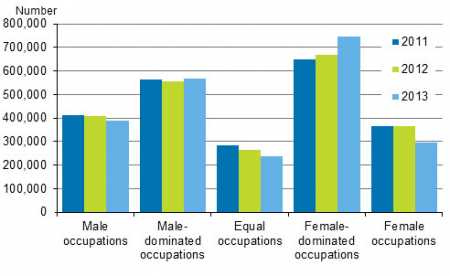|
Sun, 25 Oct, 2015 12:08:54 AM FTimes Report, Oct 25  Number of employed persons in various segregation classes in 2011 to 2013. Source: Employment Statistics, Statistics Finland. At least 10.2 per cent of all employed persons in 2013 were in equal occupational groups, where the share of different sexes among those included in the occupational group is 40 to 60 per cent, according to Statistics Finland's employment statistics.
The share was 1.2 percentage points smaller than in 2012 and 1.8 percentage points smaller than in 2011.
The strength of the segregation is determined based on how many employed persons work in equal occupational groups.
In 2013, over 235,800 persons worked in equal occupational groups. The most common equal occupational groups were teachers in vocational education (around 16,100 persons), food and related products machine operators (15,700 persons), and advertising and marketing professionals (13,800), the data show.
The most common occupational groups where the sex shares were most equally divided (share of women/men 49 to 51 per cent) were food and related products machine operators (15,700), graphic and multimedia designers (3,300), and dairy and livestock workers (2,100).
Professional differentiation by sex, segregation, is based on the classification of occupational groups by gender proportions.
Decreasing working in equal occupational groups is to some extent explained by the previously equal occupational groups becoming more female or male-dominated.
In 2012 to 2013, for example, policy administration professionals, judges, and human resource managers became female-dominated occupations.
The occupational groups of mail carriers, assemblers of electrical and electronic equipment, and mathematicians, actuaries and statisticians became male-dominated occupations in 2012 to 2013 as per the statistics.
On the other hand, some completely new equal occupational groups were born in 2013. The biggest of these groups were real estate agents and property managers, credit and loan officers, photographers, and authors and related writers.
In 2013, around 750,000 persons worked in female-dominated occupations, or 32.5 per cent of all employed persons. The share was four percentage points higher than in 2012.
The most common female-dominated occupations were shop sales assistants , office cleaners and primary school and early childhood teachers.
An increasing share of employed women, 49.4 per cent, worked in female-dominated occupations and a decreasing share, 23.9 per cent, in female occupations in 2013.
Of female occupation in 2012, general secretaries, government social benefits officials, and hospital and institutional helpers became female-dominated in 2013.
By contrast, employed men were distributed almost in the same way in segregation classes in 2013 and in 2012.
For men, the biggest change occurred in male-dominated occupations, where 1.5 percentage points more of men worked in 2013 than in 2012.
New employed persons, persons changing their occupation, as well as persons moving away from employment affect the changes in the gender distribution of occupational groups.
Of those employed in 2012 altogether 237,800 persons were no longer employed or did not belong to the population in 2013.
Most employed persons left male occupations, around 11 per cent. Of all employed persons in 2013, some 199,600 were new employed persons. New employed persons were persons who were not employed or did not belong to the population in 2012.
The share of new employed persons was the highest, around nine per cent, in female-dominated occupations, according to the data.
Altogether, the number of employed persons was around 30,500 lower in 2013 than in 2012.
More News
|
|
Finland Times
| Wednesday, 07 January, 2026 |

